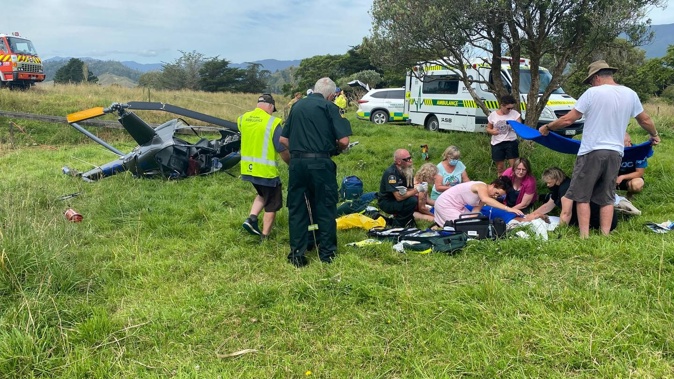

Returning to the West Coast town of Karamea after dropping two hunters in the bush, 71-year-old pilot Tony Ibbotson heard a severe bang from the rear of his helicopter.
What followed was a catastrophic break of the tail rotor in midair before the aircraft crashed to the ground, leaving Ibbotson seriously injured.
“It happened in a split second,” he told NZME. “All I can remember was something centrifugal happening – bang – and from what other people have told me, the machine did a 360-degree turn, a nose up and a nose down.”
Now an investigation has ruled the likely cause of the crash was the tail rotor spinning dangerously fast, causing the back of the helicopter to break up, colliding with the aircraft’s internal structure before the pilot lost control.
The Transport Accident Investigation Commission said it was very likely the pilot was flying the Robinson R22 outside approved rotor speed limitations, but Ibbotson rejects this.
“The overspeed happened when the machine disintegrated, not when I was flying it. It’s rubbish.”
The crash happened on January 2, 2022, when Ibbotson was returning from Kahurangi National Park after earlier taking off from a hangar at his property.
/cloudfront-ap-southeast-2.images.arcpublishing.com/nzme/LGJBYGLEDNA2XODE23DYZV2TFU.png) The Robinson R22 Beta II, taken by a passenger on the day of the crash. Photo / TAIC
The Robinson R22 Beta II, taken by a passenger on the day of the crash. Photo / TAIC
It was after dropping off the passengers that, 15 seconds into the return trip, Ibbotson noticed a vibration and a “severe” noise from the back.
He considered his options and decided to continue with the 16-minute flight back to Karamea, but chose a landing spot in a paddock, providing easy access for emergency services.
Just before 4pm, witnesses saw the helicopter pitching up and down abruptly and parts of it falling to the ground. It then crashed.
The commission’s investigation found the weather was good and the condition of the helicopter was sound.
It said it was unlikely the helicopter had a pre-existing mechanical fault that caused the rotor overspeed, finding it likely the craft was being flown contrary to its limitations, exceeding the maximum number of revolutions per minute.
In an interview with NZME published in April last year, Ibbotson said he believed the crash was the result of a mechanical failure.
“Obviously something went wrong with the machine. I didn’t crash it, the machine crashed me.”
His theory at the time was that a fault occurred somewhere along the tail rotor driveshaft, between the machine’s two gearboxes.
Speaking today, he remained firm in his view, labelling the investigation report “bulls***”.
“I know what an overspeed is. I know what an underspeed is and I know how to identify it.”
He said the overspeed didn’t occur until right before he landed, which is what sparked the crash.
One of the commission’s key recommendations not related to the cause of the crash surrounded the use of “hook and loop retaining straps”, known to many as Velcro.
In this incident, the helicopter’s emergency locator transmitter (ELT) was held in place by Velcro, as is common in many helicopters. The strap ripped during the accident and the transmitter failed to activate.
/cloudfront-ap-southeast-2.images.arcpublishing.com/nzme/JJP5HS3IELRFPQZ7ZXR5DHNHEY.jpg) Karamea helicopter pilot Tony Ibbotson visiting the crash site for the first time since the incident on January 2, 2022. Photo / George Heard
Karamea helicopter pilot Tony Ibbotson visiting the crash site for the first time since the incident on January 2, 2022. Photo / George Heard
“There is a risk of these hook and loop retaining straps losing their designed capability to retain ELTs during accidents, thereby rendering the ELTs ineffective and causing delays in lifesaving search and rescue operations,” the commission found.
The straps are compliant with regulations, but the commission wrote to the Civil Aviation Authority (CAA) recommending a review of the straps’ suitability. The CAA has started this review.
Ibbotson, a butcher by trade, was a commercial fisherman when he arrived in Karamea from Tākaka in 1981.
He soon got into commercial helicopter flights, working with the Department of Conservation (DoC), fishermen and rafters.
He didn’t fly for a year after the incident but is now flying again privately. He doesn’t operate commercially, continuing to earn a living as a butcher.
He says his injuries have healed but he has “more screws in my body than my shed”.
Ethan Griffiths covers crime and justice stories nationwide for Open Justice. He joined NZME in 2020, previously working as a regional reporter in Whanganui and South Taranaki.

Take your Radio, Podcasts and Music with you









